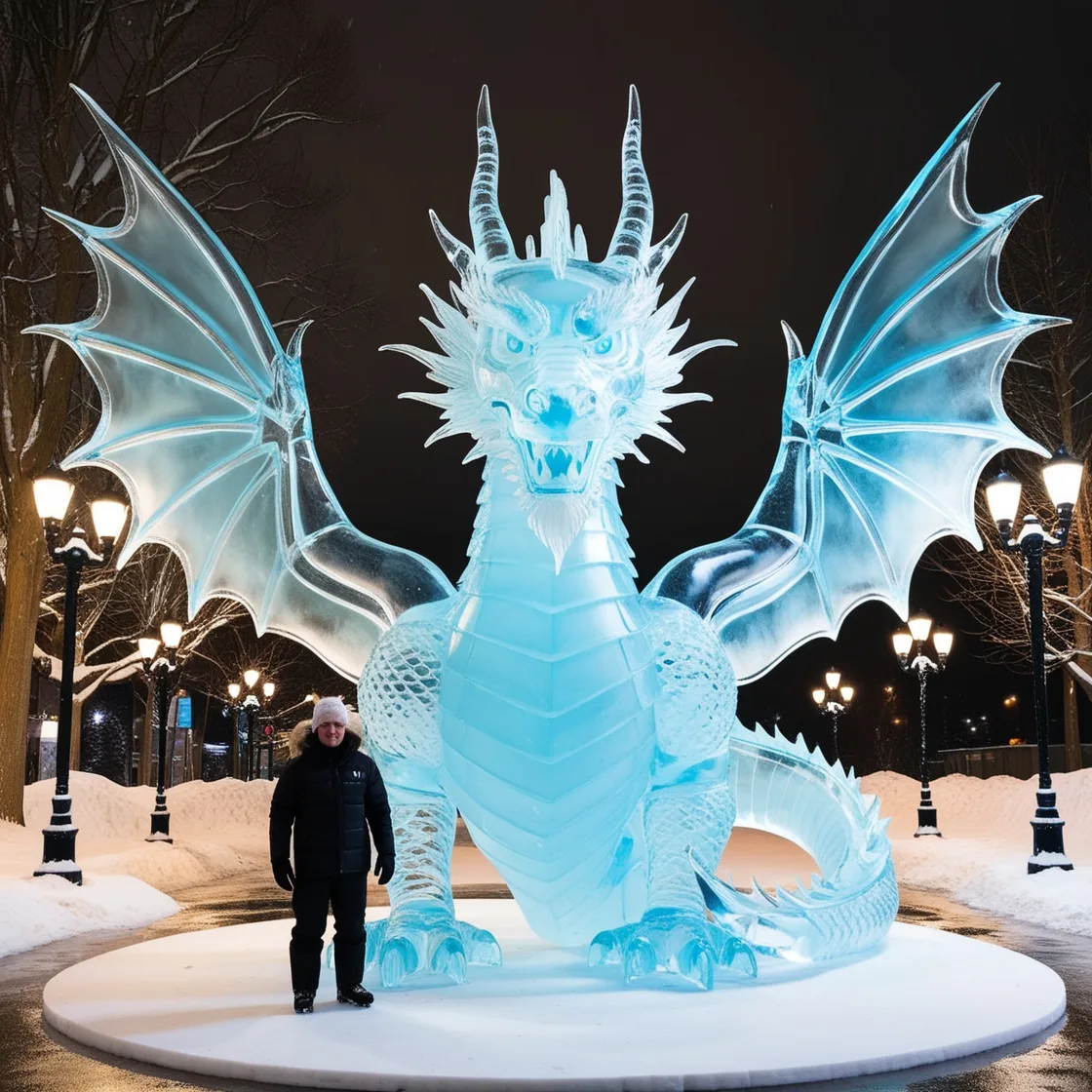Ice sculpture is a breathtaking art form, and among the most captivating designs are ice dragon sculptures. These frosty creations evoke a sense of magic, mysticism, and unparalleled craftsmanship. Carved from solid blocks of ice, they transform ordinary frozen water into intricate works of art that leave spectators in awe.
In this blog post, we’ll take you on a journey into the world of ice dragon sculptures, exploring how they’re made, the history behind them, and where you can see them in all their frozen glory.
What Are Ice Dragon Sculptures?
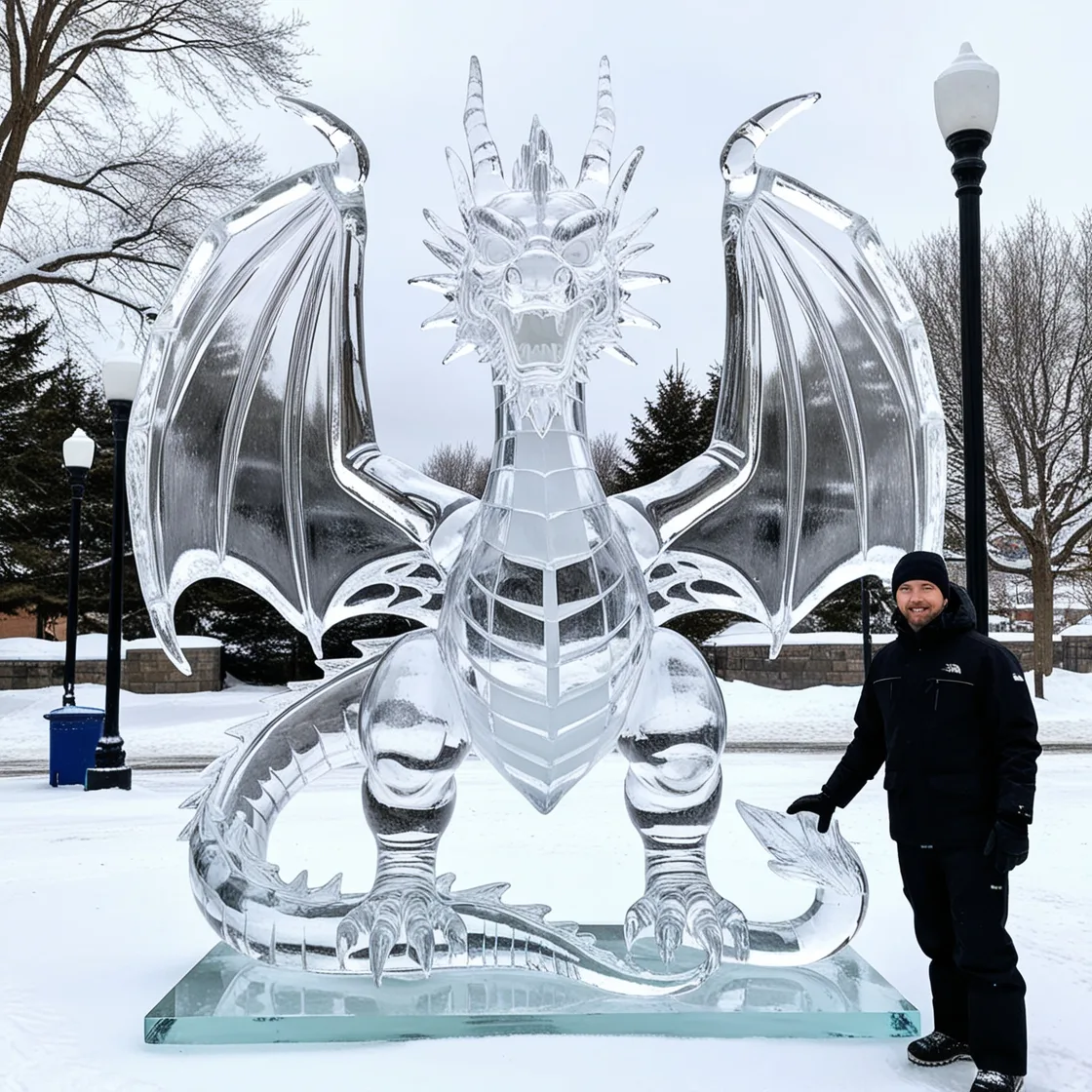
Ice dragon sculptures are life-like or fantastical representations of dragons created using ice as the primary medium. These sculptures are often seen at winter festivals, ice carving competitions, and special art exhibitions. The most elaborate of these works can be monumental, sometimes standing several feet tall, with wings, scales, and fiery expressions carved into the frozen medium.
Why Ice?
The choice of ice as a medium for dragon sculptures adds an element of transience to the work. Ice is a fragile material that melts over time, giving ice dragon sculptures a fleeting beauty. This temporal nature of the art form makes the sculpture even more special, as it’s a reminder that all beauty is temporary.
Moreover, the translucent quality of ice allows light to pass through the sculpture, giving the dragon an ethereal glow when lit from below or behind. This enhances the magical effect that these sculptures often evoke.
The Craftsmanship Behind Ice Dragon Sculptures
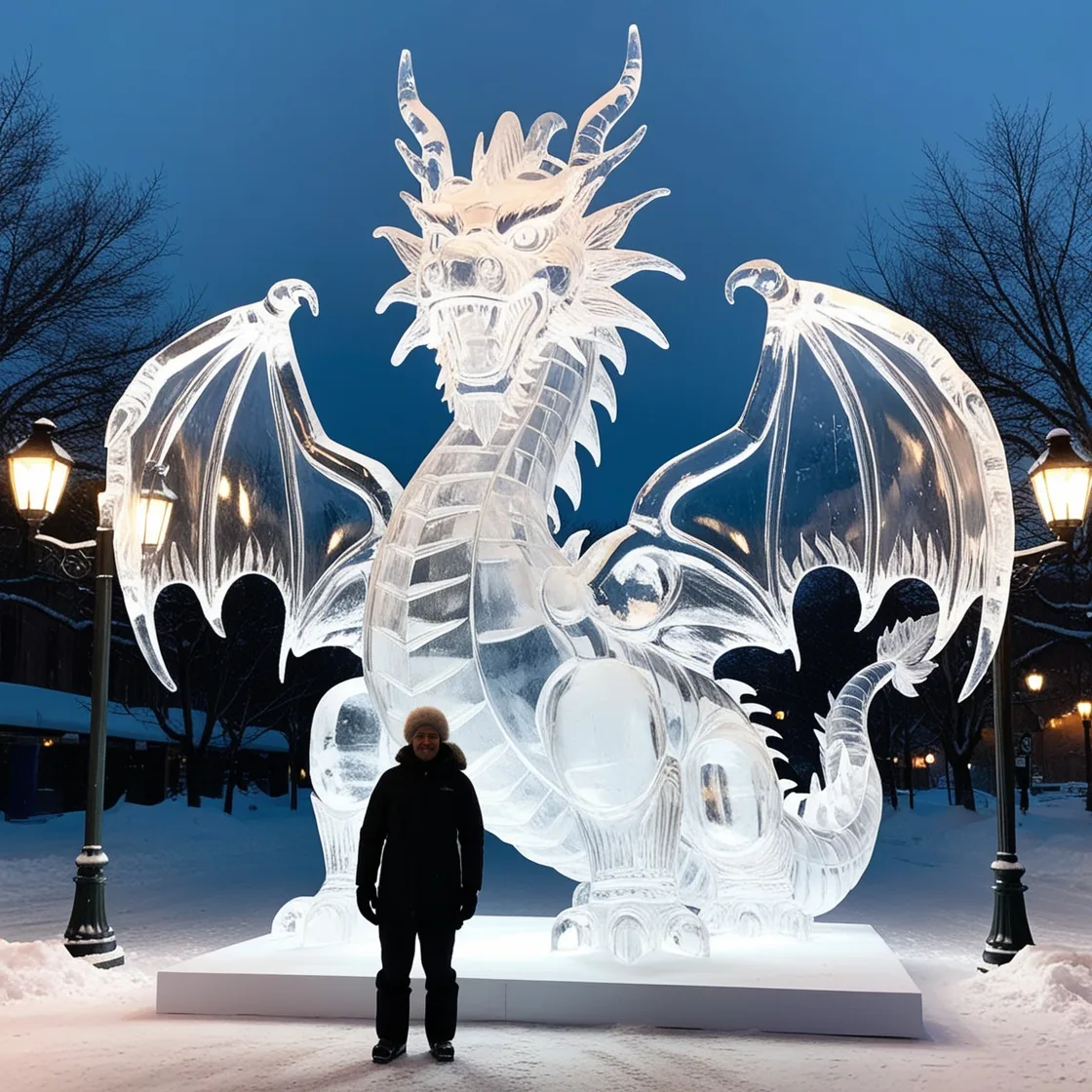
The Ice Carving Process
Creating an ice dragon sculpture requires an immense amount of skill, precision, and patience. While the process might seem straightforward, it’s incredibly technical and demands a high degree of artistry.
Step 1: Selecting the Ice
The first step in creating an ice sculpture is selecting the right block of ice. Artists typically use clear blocks that have been frozen specifically for carving, as these are free from air bubbles, ensuring the finished sculpture is both durable and visually striking. Some artists even create their own blocks by freezing water in large containers.
Step 2: Planning the Design
Before artists start carving, they sketch out their design, paying close attention to the dragon’s features: wings, tail, claws, and facial expressions. Creating an ice dragon sculpture is like sculpting a living creature, with attention to detail being paramount. Some artists even sketch in 3D to get a more accurate sense of how the sculpture will look from various angles.
Step 3: Rough Carving
Once the design is finalized, artists use chainsaws or large knives to cut away the bulk of the ice. This stage is focused on getting the basic shape of the dragon: its body, wings, and pose. The sculptor will typically remove large chunks of ice to establish the main forms and proportions.
Step 4: Detail Work
After the rough carving, it’s time to add finer details. This involves using smaller tools such as chisels, gouges, and scrapers to carve out intricate patterns like the dragon’s scales, claws, and facial features. This step requires extreme patience and skill, as the sculptor has to work delicately to avoid cracking the ice.
Step 5: Finishing Touches
The final touches are the most critical. Sculptors may use sandpaper to smooth rough edges, and they might even apply water to the surface to create a glass-like finish. Some sculptures are also lit with colored lights to enhance their appearance.
Types of Ice Dragon Sculptures
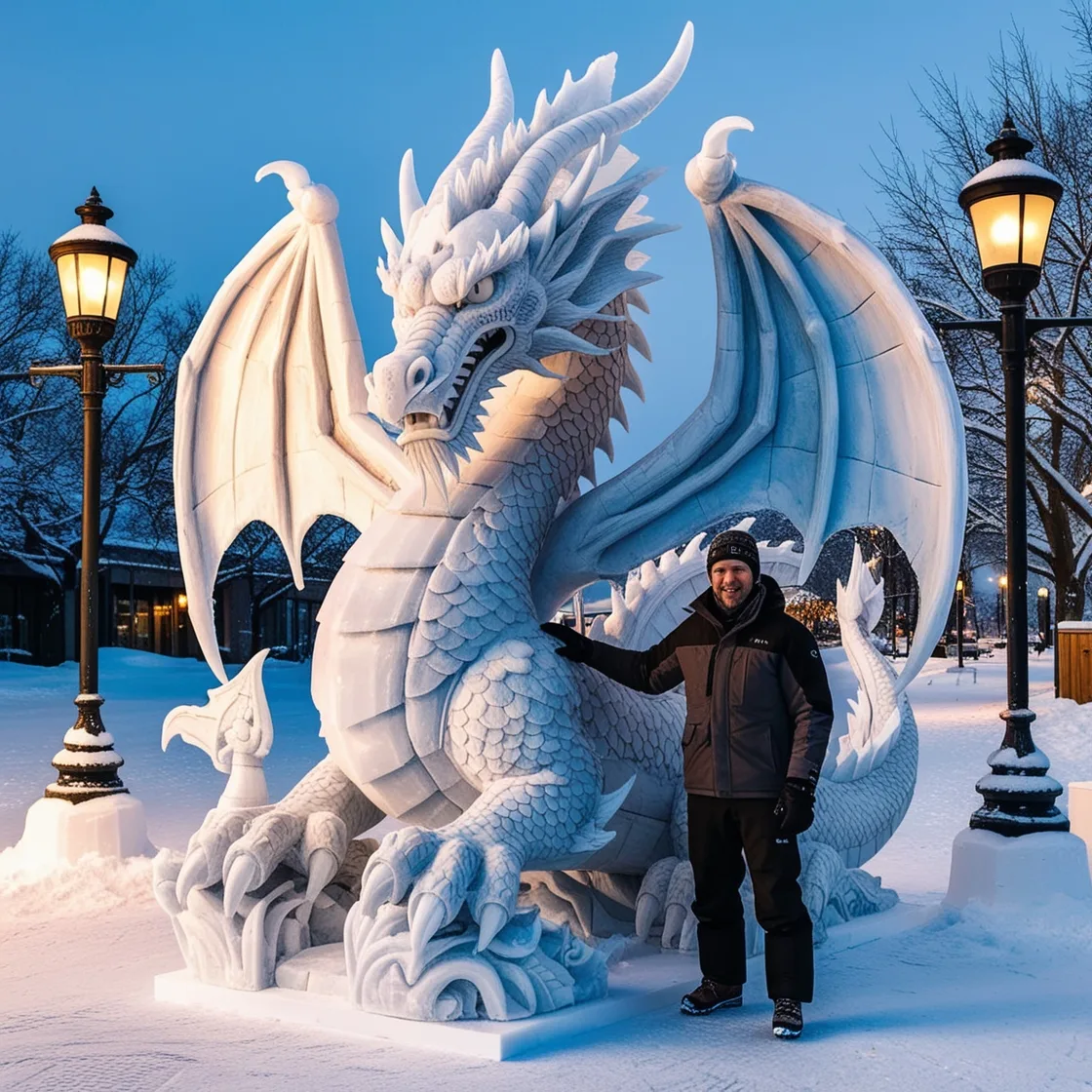
Realistic Dragons
Realistic ice dragons closely resemble the dragons of fantasy lore, from the traditional European dragon with wings and scales to the serpentine dragons found in Eastern cultures. These sculptures are often displayed in exhibitions where high levels of detail are the focus, including facial features and the texture of the ice resembling scales.
Fantasy Dragons
Fantasy ice dragons might take inspiration from popular culture, depicting dragons as fierce, mythical creatures. These sculptures often have exaggerated features like enormous claws, fiery eyes, or impossibly large wings. Artists may even depict dragons in action, such as flying or breathing fire (using special lighting effects).
Abstract Ice Dragons
Some ice dragon sculptures take a more abstract approach, emphasizing shape, form, and fluidity. These sculptures might not have the classic dragon appearance but still evoke the spirit of a dragon, using curved lines, sharp angles, or flowing shapes to represent movement or power.
Where to See Ice Dragon Sculptures
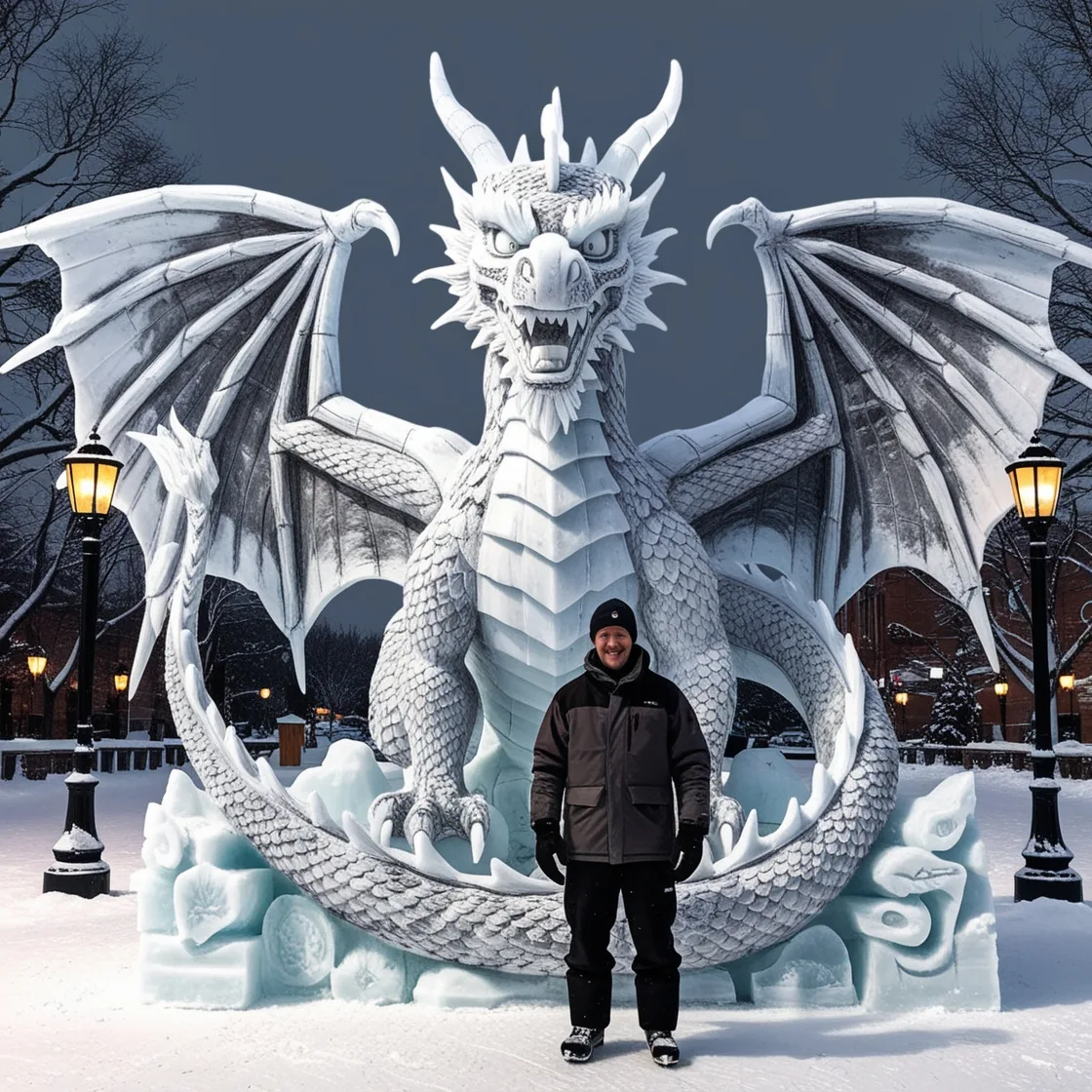
Winter Festivals
Ice dragon sculptures are often showcased at winter festivals, where ice carvers from around the world gather to compete and display their works. These festivals create a magical atmosphere where the sculptures are illuminated against the backdrop of snow and ice, making for a spectacular display. Some notable events include:
- Harbin International Ice and Snow Sculpture Festival (China): One of the largest and most famous winter festivals, this event features giant ice sculptures, including intricate dragon sculptures.
- Sapporo Snow Festival (Japan): Known for its snow and ice sculptures, this festival also frequently includes dragon-themed carvings.
- Quebec City Winter Carnival (Canada): This annual festival often showcases stunning ice sculptures, with dragons being a common subject.
Ice Sculpting Competitions
Ice sculpting competitions are another place where you might find impressive ice dragon sculptures. These competitions gather top ice carvers who create their best works in a limited time frame. The sculptures are often on display for a few days before they melt away, offering a brief opportunity to marvel at the talent on display.
Art Galleries and Exhibitions
In some art galleries, particularly those that focus on winter or seasonal art, you may encounter ice sculptures as part of temporary exhibits. These sculptures are usually displayed in refrigerated rooms to preserve their shape for the duration of the exhibition.
The Magic of Ice Dragon Sculptures
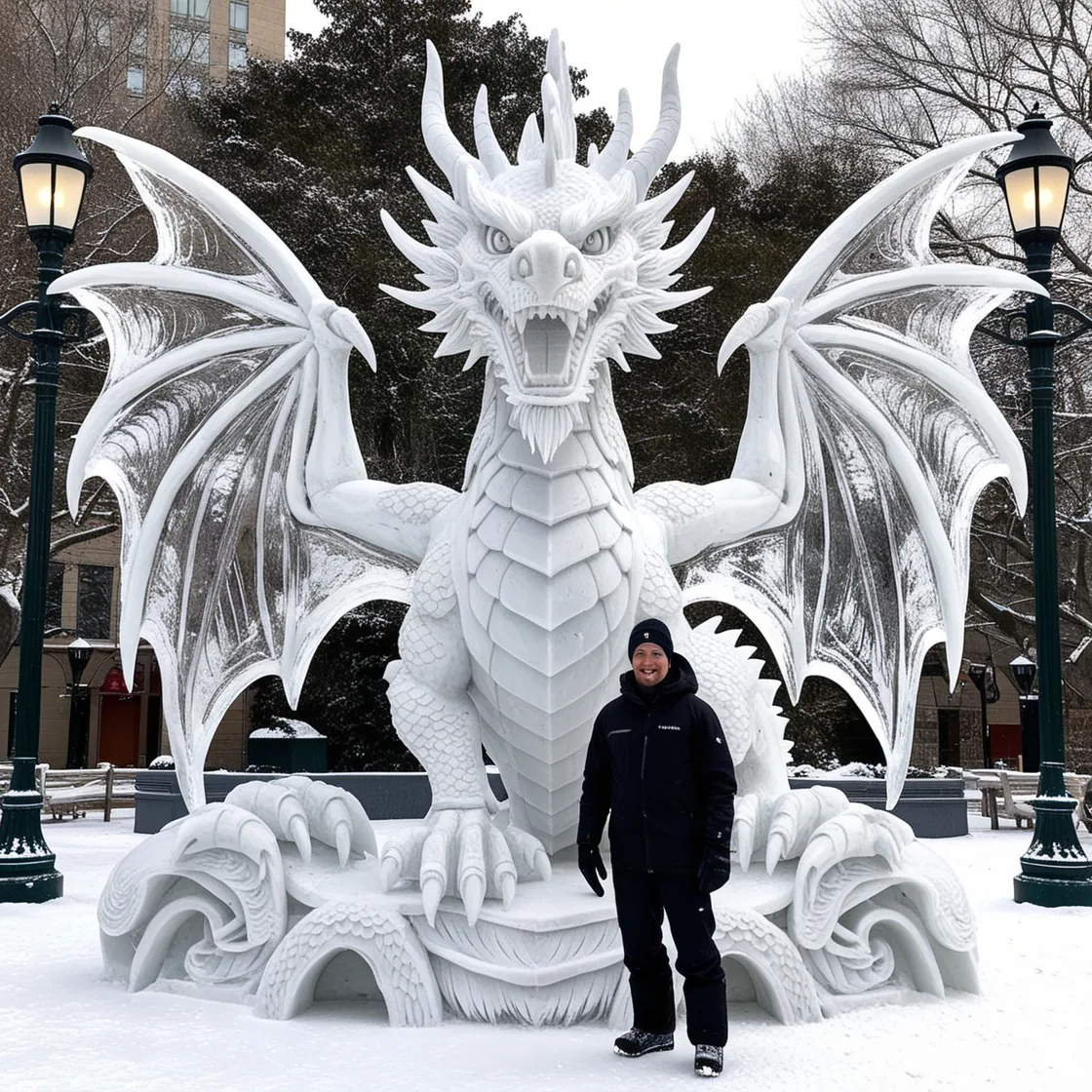
What makes ice dragon sculptures truly magical is their impermanence. Unlike traditional sculptures made of stone, wood, or metal, ice sculptures are fleeting by nature. Their beauty is most appreciated during their short lifespan—once the temperature rises, they begin to melt and lose their form.
This impermanence adds an emotional layer to the appreciation of ice dragon sculptures, as they symbolize the transient nature of life, art, and beauty. Spectators can’t help but feel a sense of awe and wonder when witnessing these delicate creations, knowing that in a short time, they will be gone.
The Role of Technology in Ice Dragon Sculpture Design
Digital Tools for Planning and Design
While traditional ice sculpting is rooted in manual artistry, modern technology has begun to play a significant role in the design and execution of intricate sculptures, including ice dragons. 3D modeling software is now commonly used by artists to plan and visualize the final product before even picking up a tool. These programs allow artists to create digital representations of their designs, adjusting proportions, details, and textures before beginning the actual carving process.
Using digital tools, sculptors can also simulate how the sculpture might change as it melts. By factoring in temperature, lighting, and other environmental variables, they can make design decisions that will help the sculpture maintain its intended beauty for as long as possible. Additionally, digital designs allow artists to scale their ice dragon sculptures to any size, ensuring that the final product matches their creative vision.
Tools and Techniques Used in Ice Sculpture
While chainsaws, knives, and chisels are still the primary tools for ice sculpting, some advanced techniques are now being incorporated to create more complex and refined details. Laser etching is one example. Artists can use lasers to create intricate designs on the surface of the ice, such as fine dragon scales or delicate veins in the wings. This precise technique allows for details that would be impossible to achieve with traditional sculpting methods alone.
Another modern technique involves using cold water or air sprayers to smooth out the surface of the ice or add texture, enhancing the appearance of scales, fur, or any intricate pattern the artist wishes to include. This ability to apply texture on a granular level results in ice dragon sculptures that feel both lifelike and mythical, as though they might spring to life at any moment.
The Future of Ice Dragon Sculptures
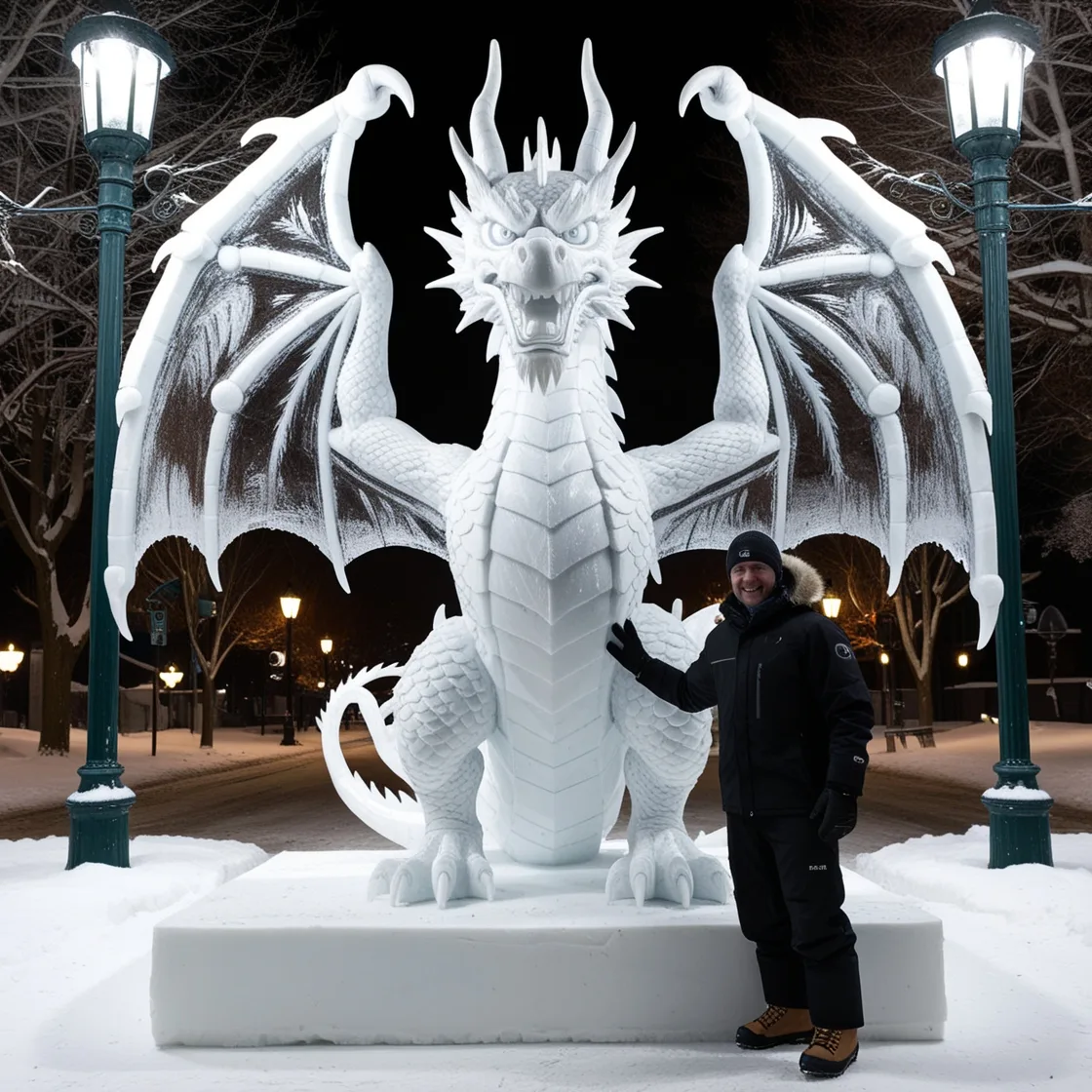
As technology continues to evolve and artists experiment with new techniques and tools, the future of ice dragon sculptures looks incredibly exciting. The combination of artistic vision with high-tech innovations has the potential to push the boundaries of what can be achieved with ice.
Augmented Reality and Interactive Displays
One of the emerging trends in ice sculpture displays is the use of augmented reality (AR). Through AR, viewers can interact with ice sculptures in entirely new ways. Imagine standing before an ice dragon sculpture and using your smartphone to watch the dragon’s wings flap or its eyes glow. This blending of physical art with digital enhancements could revolutionize the way people experience ice dragon sculptures, turning them into interactive art installations.
Sculpting with New Materials
While traditional ice sculpture is still primarily made with water-based ice, new materials might find their way into the field of ice sculpture, broadening the range of possibilities for creating ice dragon masterpieces. For instance, sculptors may experiment with crystal-clear or colored ice, allowing them to create even more visually striking and unique pieces. Additionally, incorporating reflective or light-reactive elements into the sculptures could make them even more mesmerizing when illuminated in dark settings.
Why Ice Dragon Sculptures Make a Lasting Impact
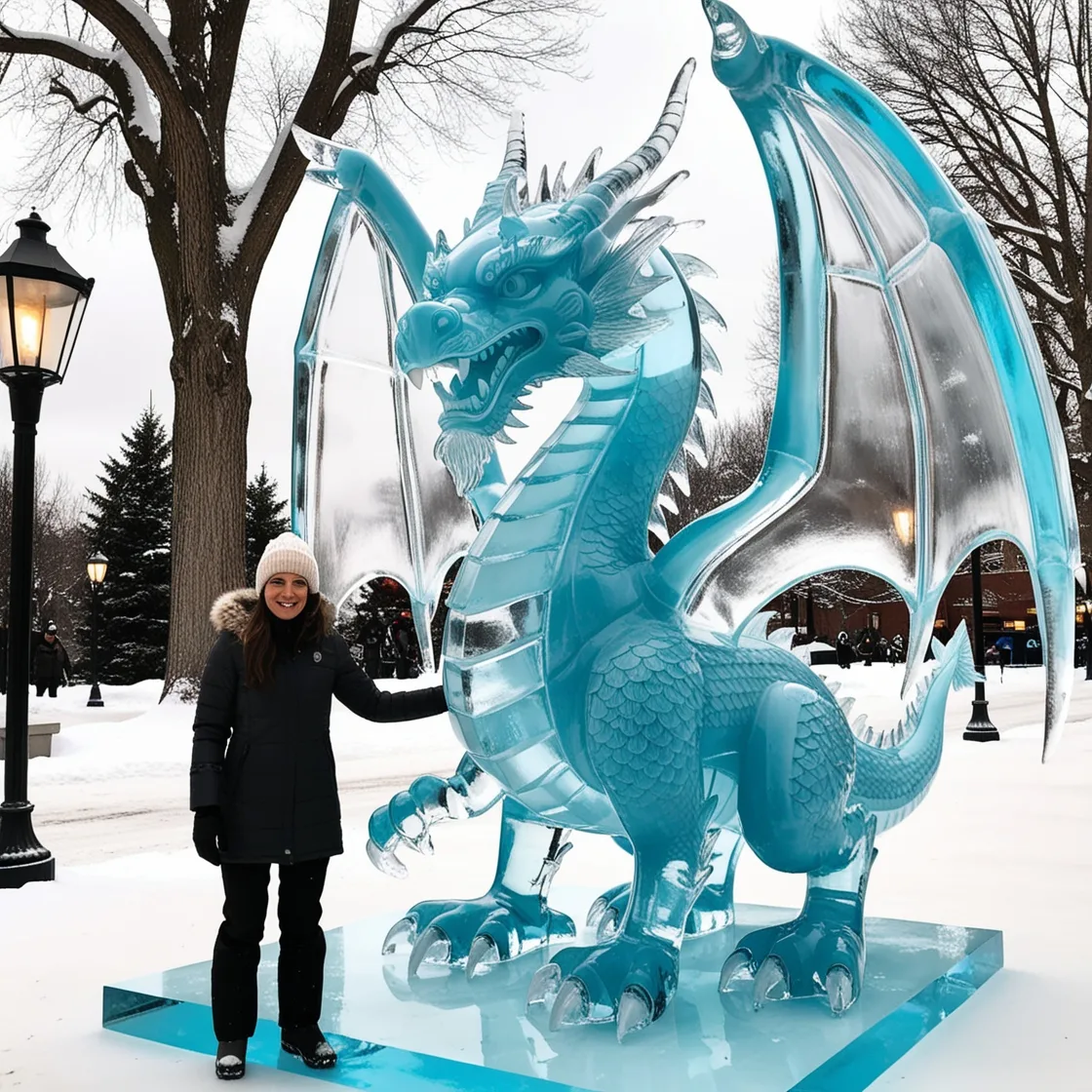
Although ice dragon sculptures are temporary, their impact on viewers can be long-lasting. People often leave exhibitions or festivals with vivid memories of the stunning beauty and intricacy of the sculptures they’ve witnessed. The fleeting nature of the art form invites us to appreciate the present moment fully and reminds us of the impermanence of all things—beauty, life, and even the art we create.
Building a Connection with Nature
Ice sculptures, particularly those shaped like dragons, also establish a connection between the viewer and the natural world. Dragons, as mythical creatures, are often associated with nature’s elements: fire, air, water, and earth. By shaping an ice dragon, artists are tapping into that elemental energy, connecting the art with the natural forces of the earth in an incredibly visceral way.
The use of ice, which is essentially frozen water, highlights the purity of nature and the fragility of life. Watching an ice dragon sculpture slowly melt serves as a reminder of the impermanence of nature itself. This connection between art, nature, and life creates a profound experience for those who encounter the sculptures.
How to Experience Ice Dragon Sculptures
If you want to experience ice dragon sculptures firsthand, here are a few tips to make the most of your visit:
Plan Your Trip During Winter Festivals
Many of the best ice dragon sculptures can be found at large-scale winter festivals and events. Check the schedules of renowned festivals like the Harbin International Ice and Snow Sculpture Festival or the Sapporo Snow Festival to plan your visit. These festivals attract top-tier artists from around the world, offering a wide variety of dragon sculptures that are sure to leave you in awe.
Stay After Dark
The beauty of ice sculptures is truly revealed when they’re illuminated by colorful lights. Attend evening events or special “ice-lighting” sessions to see the dragons come to life with glowing effects. These lights transform the ice into a magical spectacle, casting shadows and creating an otherworldly atmosphere around the sculptures.
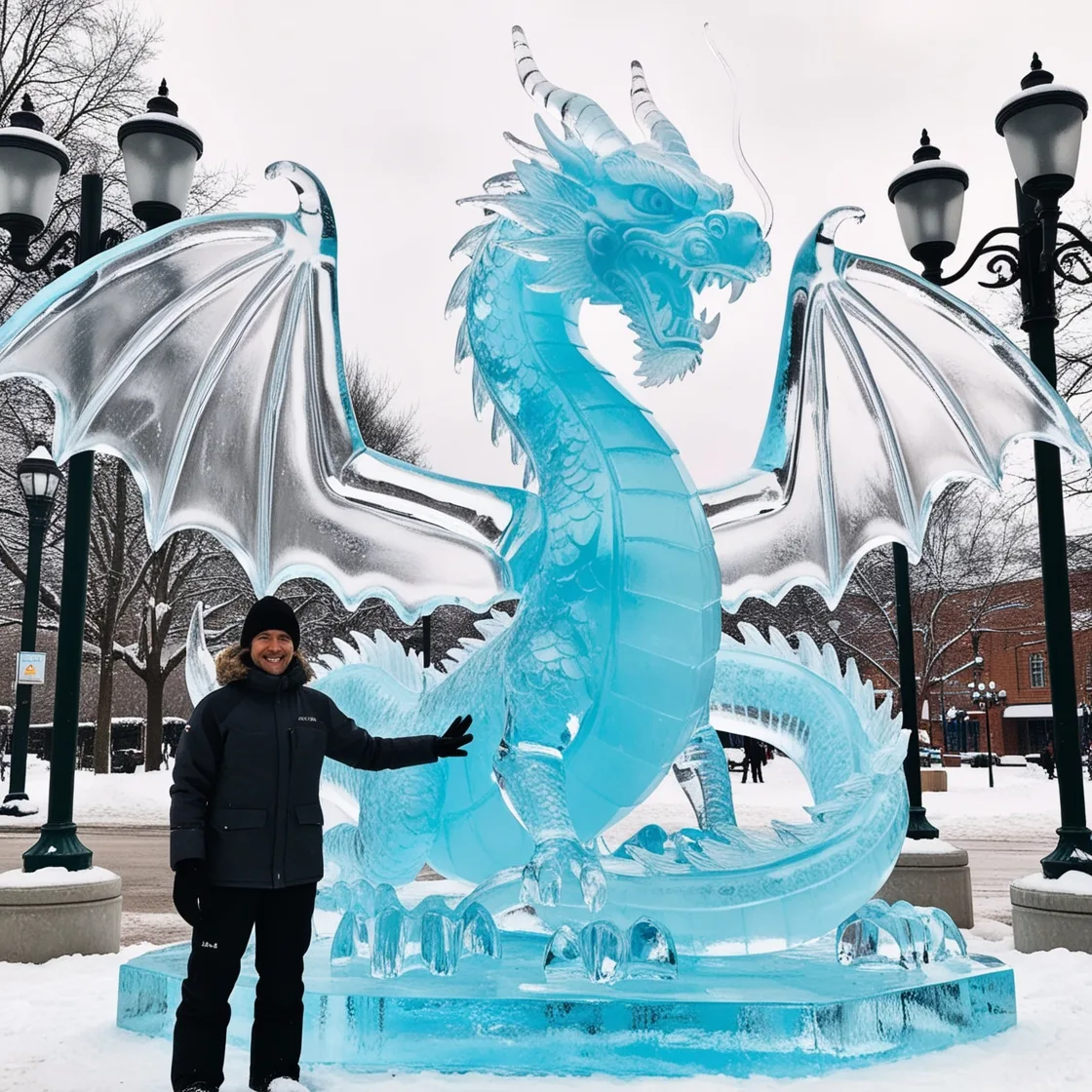
Participate in Ice Carving Workshops
Some ice festivals and events offer workshops where visitors can try their hand at ice carving under the guidance of experienced artists. While creating a full-sized ice dragon might be a bit ambitious for beginners, you can learn how to carve simpler designs and appreciate the precision that goes into each sculpture. This hands-on experience can deepen your appreciation of the art form.
Take Photos and Share the Magic
Ice sculptures are inherently temporary, so capturing photographs of them can help preserve the beauty and magic of the moment. Share your photos with friends and on social media to inspire others to appreciate the delicate art of ice carving. Just be sure to respect the artists’ work by not using flash photography, which could damage the sculptures.
The Eternal Magic of Ice Dragon Sculptures
Ice dragon sculptures stand as a testament to human creativity, ingenuity, and the delicate balance between nature and art. Though these masterpieces may be temporary, the impressions they leave on our minds are permanent. Whether you’re marveling at the fine details of a life-sized dragon or simply enjoying the magical atmosphere of a winter festival, ice dragon sculptures offer a unique experience that connects us to the beauty of nature and the fleeting nature of time.
From their intricate design to their ethereal glow, ice dragon sculptures are a celebration of artistry and wonder. As technology advances and new materials are introduced, we can only imagine how this art form will continue to evolve, but one thing is for certain: the allure of the ice dragon will continue to captivate hearts and imaginations for years to come.
So next time you get the chance to witness these frosty creatures in person, don’t let it slip away. Let the magic of the ice dragon sculpture enchant you—if only for a little while.

